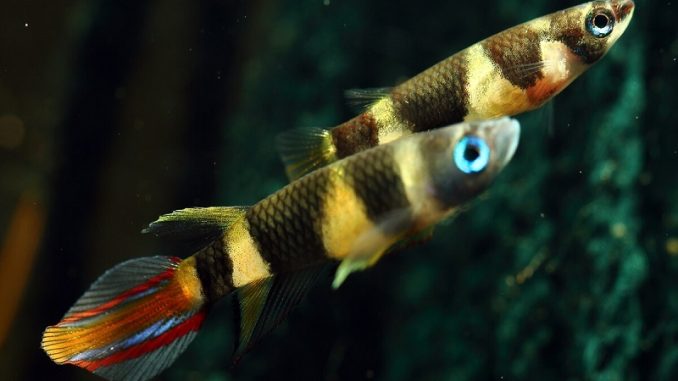
Hoping to populate a micro or nano tank with a fun and colorful fish? Looking to add a splash of color to the top level of your community aquarium? If you answered yes to either of the above questions, consider the Clown Killifish, one of the tiniest killifish around.
Clown Killies are top-level dwellers, so if you have a larger nano tank and are searching for something to fill in that often overlooked section, these micro predators are a great choice. It’s fun to watch them lay in wait for their prey to swim by, at which point they’ll use their upturned mouths to grab it off the surface of the water.
In this article, I’ll cover everything you need to know about keeping Clown Killifish happy and healthy. I’ll discuss their natural habitat and origins so that you can provide them with the optimal conditions and care so that they can reach their full potential in your home aquarium.
TABLE OF CONTENTS
Clown Killifish Facts & Overview
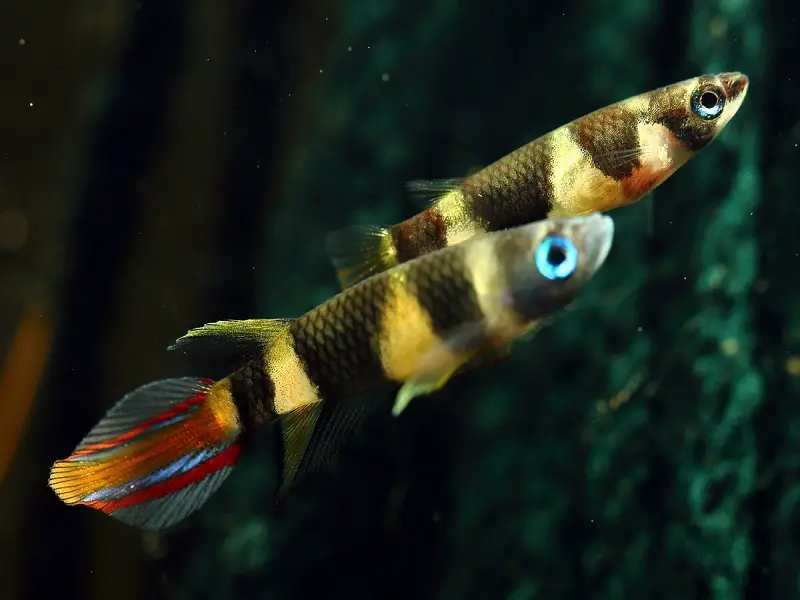
| Category | Rating |
| Care Level: | Easy to moderate |
| Temperament: | Peaceful predator |
| Color Form: | Varied bright colors |
| Lifespan: | 5 years |
| Size: | 1.2-1.4 inches (3-3.5 cm) |
| Diet: | Carnivore |
| Family: | Nothobranchiidae |
| Minimum Tank Size: | 5 gallons |
| Tank Set-Up: | Freshwater with plants and rocks |
| Compatibility: | Peaceful community |
If you’re looking for fun fish that will entertain, yet don’t require too much space, I highly recommend some Clown Killifish.
Hailing from western Africa and found in the countries of southern Guinea, Liberia, and Sierra Leone, Clown Killifish, scientific name Epiplatys annulatus, are peaceful micro-predators that feed mostly on tiny flying insects and invertebrates.
In their natural habitat, this tiny prey is abundant in the marshes, streams, swamps, and water holes that Clown Killies call home.
It’s vital for the home hobbyist to be familiar with their wild habitat as such knowledge will aid the aquarium enthusiast in providing the proper conditions for these tiny treasures. As they are predators, they will need you to provide live prey; pellets and flakes will not allow for the kill that makes them thrive.
Additionally, stream and swamp water are extremely slow-moving, and Clown Killies will therefore need still waters or at the very least a slow current. This water requirement is significant for a couple of reasons. First, the cleanliness of the tank is more challenging without a filter. It’s not as much of an issue in the wild because the water body is so much larger, but in a micro or nano tank, it can be more challenging to keep things clean.
If you have no filter, you will have to compensate with regular water changes and abundant foliage, which will help keep the water clean. The second consideration is other aquarium habitats. Some loaches and tetras, for example, require a strong current, and therefore they would not be good choices for tankmates for Clown Killifish.
Clown Killies are also known as rocket killies and banded panchax, although the latter name is certainly not as common.
Enthusiasts who are familiar with killifish will be interested to know that they fall into the majority size range of other killifish. There are 1,270 different species of killifish, and they range in size from 1 inch (2.5 cm) to 6 inches (15 cm). The majority are between 1-2 inches (2.5-5 cm), including Clown Killies.
Clown Killifish have been in the aquarium hobby in the United States since the 1960s, and although their name implies that they are labeled for their predatory habits, the true origin comes from Dutch. Kilde is the Dutch word for channel or ditch, similar to the killifish’s habitat, and that’s where the name comes from.
The Clown Killies that you purchase will likely have been bred in captivity, yet they are not extinct in the wild and can still be found in western Africa. Even though your Clown Killies will have never experienced the densely planted swamps of Africa, they still require these conditions to thrive.
Typical Behavior
Clown Killifish are peaceful fish, but they are predators. Instead of chasing their prey, they lie in wait near the water’s surface. When unsuspecting insects skim the surface, the Clown Killies ambush them, grabbing them with their upturned mouths.
Because they are so small, they are more in danger from other fish than they are to them, so they need to be housed with other small fish if you are not keeping a dedicated tank. They are shy, so Clown Killifish do better in groups of up to 10 fish. When they are in groups, they are less shy and more playful.
Speaking of play, Clown Killies are accomplished jumpers, and thus you would be wise to maintain a tight-fitting tank for these little fish.
To keep them happy, make sure the light is not too bright and that the water current is still or extremely slow. They will also appreciate a habitat that is similar to the streams and marshes of their native Africa. Given the right conditions, these fish have a lifespan of about 5 years.
Like many species, male Clown Killifish love to show off, so prepare to be entertained if you’re hosting a school.
Appearance
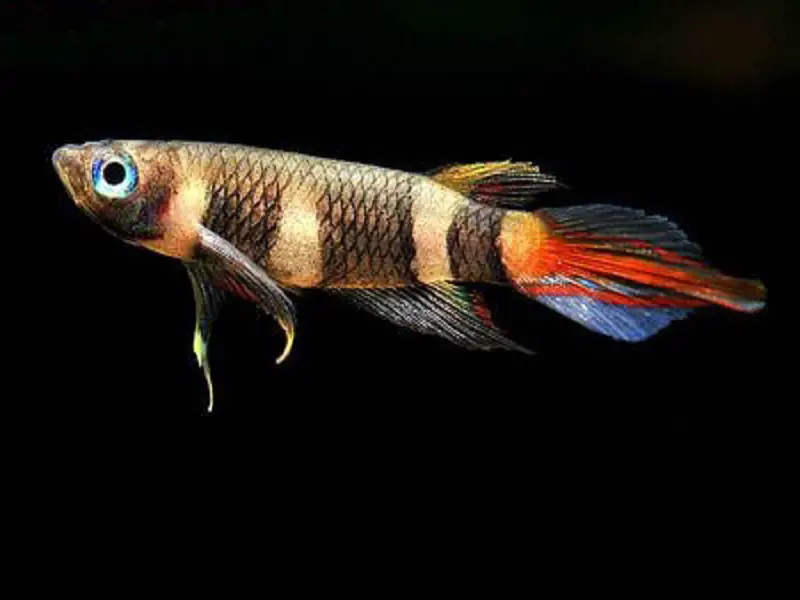
Clown Killifish look like little rockets (they are even called Rocket Killifish sometimes), with bodies that are shaped like torpedoes. Since they are surface feeders, their mouths turn up for easy access to food. Clown Killies have dorsal fins that are set further back toward the tail.
The tail fin is shaped like a spade and has long rays, and their heads are round, so their appearance is reminiscent of a tiny pike. Clown Killies are small, averaging only 1.2 to 1.4 inches (3-3.5 cm) in length.
Clown Killifish, scientific name Epiplatys annulatus, get their names from their bright colors that actually look like clown makeup. Clown Killifish, like most killifish, are sexually dimorphic, so it’s easy to distinguish between males and females.
The male Clown Killies are more brightly colored, and their bodies have black and yellow stripes, while their tails have blue and red stripes. The females, who are on the smaller side, are not as brightly colored as the males. Other differences include the rays on the caudal fin, which are longer on the males than the females.
Fun Fact: Although I’ve described the black/yellow, blue/red coloration pattern Clown Killies have a wide range of color variation, even within the same brood. Even the stripes can vary in width.
While females and males both have cream-colored bodies with stripes, fin colors vary between females and males: the female’s dorsal fin is clear while the males’ fin varies from blue to cream to red, and sometimes even a red-flecked blue. The males also have light blue caudal fins with fantastic rays that range from yellow to orange to red.
Habitat and Tank Conditions
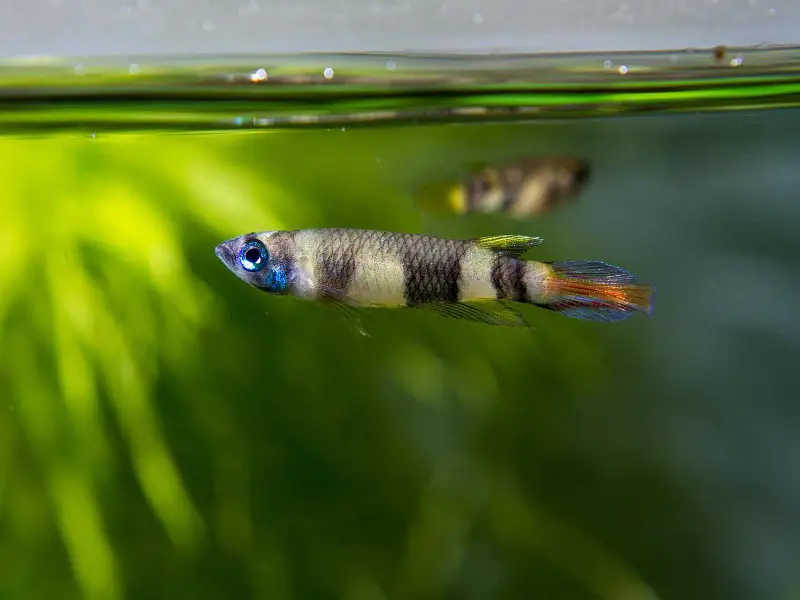
You can use a micro or nano tank for Clown Killifish; they’re tiny enough that you can house multiples in a tank that small. You can also choose to house them in a larger community tank that already has a bottom and mid-tank inhabitants; that way the Clown Killies can occupy the top part of the tank.
There are some benefits and drawbacks of smaller and larger tanks. You should be aware that Clown KIllifish won’t reproduce as much if they share a larger tank with other species, so if you’re hoping for Clown Killifish fry, you may want to choose the smaller, dedicated tank.
However, a smaller tank usually has a strong filter that produces too strong a current for Clown Killies.
You could forgo the filter and use a planted tank. This setup offers a number of benefits: the floating plants will help keep the tank clean; offer a space for Clown Killies to lay their eggs; provide cover for the fry, and make necessary hiding places for the shy adult Clown Killifish.
Good plant choices include Guppy Grass (watch for overgrowth!), Java Ferns, Water Lettuce, and Water Sprites. Clown Killies will also appreciate driftwood in their tank.
Water Conditions
In the wild, Clown Killifish enjoy soft water that is warm and acidic, so you’ll want to recreate these conditions in the home aquarium. You want to maintain a water hardness of 50 ppm.
You can precondition the water in advance of adding the fish. In a separate container, add the tank water and soak peat in a box filter for a few days. The water will get an amber tint and this is right for the Clown Killifish.
The optimal parameters to ensure a close match to their natural habitat are:
- pH levels: 4-7
- Water hardness: 4-8 dKH
- Water temperature: 68° – 79° F (20° – 26° C)
Maintaining these parameters will ensure that you will have a successful breeding environment if that is your goal.
Filter or no filter
If you are not using a filter to honor the Clown Killies’ preference for still water, you should perform a water change of at least 50 percent every few days. You should also make sure you have sufficient plants so that they can absorb much of the ammonia and nitrates that compromise the tank. Maintaining clean water will ensure your fish’s health.
If you are using a filter, make sure to put plants or decorations in front of it to curtail direct flow that will unnerve the Clown Killifish. You could also choose a filter that has a low flow and won’t move the water too much.
What Size Aquarium Do They Need?
If you have a dedicated Clown Killifish tank, a micro or nano tank will suffice, at least 5 gallons. The one issue with the smaller tank is that fairly strong filters are necessary to keep a smaller tank clean and Clown Killies don’t like a strong current.
If you don’t have a dedicated Clown Killifish tank, you’ll need a larger tank to accommodate everyone. Keep in mind that breeding may be hindered if Clown Killies are in a community tank.
How Many Can Be Kept Per Gallon?
Clown Killifish are really small, so you can accommodate 2 or 3 pairs in a 2-gallon tank or up to 8 pairs in a 10-gallon tank.
Tank Mates
Choose small and peaceful fish to pair with Clown Killies if you are not planning a dedicated tank for these tiny fish.
Suitable Tankmates
It’s also a good idea to choose mid-level and bottom feeders to go with Clown Killifish; that way, they can have the top tank to themselves.
Finally, small shrimp or snails are good tankmates because they help keep the water clean by eating leftover food and detritus. Also, be sure to choose tankmates that also thrive in still or slow-moving water. You have to curate your tank carefully to make sure that all creatures have the appropriate habitat and water conditions to thrive and prosper.
Keeping Clown Killifish Together
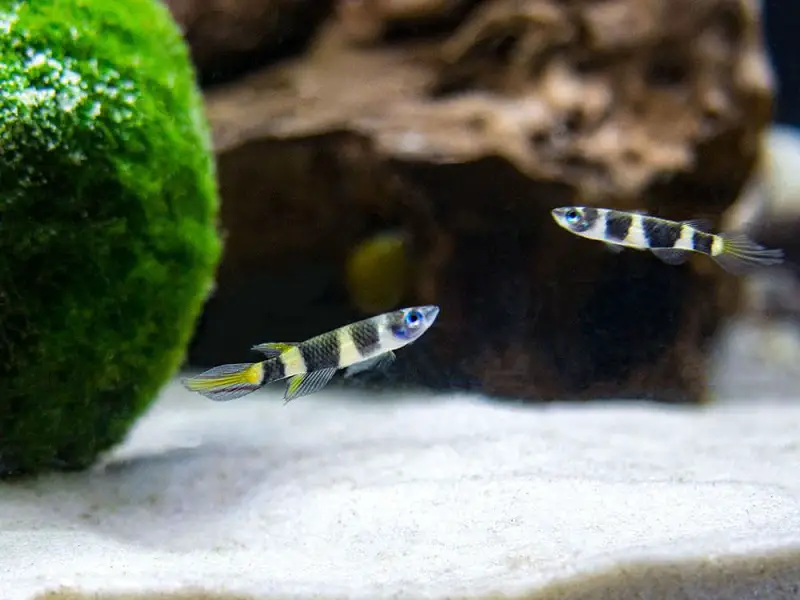
Clown Killifish do well in shoals, as they are very shy, and being together reduces their stress. You may witness some aggression between the males when it’s time to breed. But normally they pair off, and it’s fun to watch these colorful tiny fish swimming around the tank in groups.
Diet
Clown Killies are carnivores, so they need live and frozen meaty proteins. The only catch is that because they are tiny, they need tiny portions of meaty protein, like insects. They lay in wait for the insects to land on the water’s surface and then go in for their prey.
This is what they’ll eat in the wild, and this is what you should mimic in captivity. Try a combination of the following foods 1-2 times a day:
- Baby Brine Shrimp
- Confused Flour Beetles
- Confused Flour Beetle Larvae
- Copepods
- Fruit Flies
- Microworms
- Moina
- Mosquito Larvae
- Small Daphnia
- Small Grindal Worms
- Vinegar Eels
- Walter Worms
Care
Probably the most difficult part of caring for Clown Killifish is maintaining the delicate balance of low water flow and cleanliness. If you are not using a filter, perform a 50 percent water change every few days. If you are using a filter, diffuse the flow with a decoration or plant in front of the filter.
With or without a filter, make sure to have plenty of plants on hand to ensure absorption of ammonia and nitrates that could harm your Clown Killies. Floating plants serve more purposes than just helping keep your tank clean. Clown Killies love to swim through the leaves of floating plants, and they also depend on them for reproduction, as they serve as spawning mats.
I’ve suggested that Clown Killies require easy to moderate care, so they would not be the best choice for an absolute beginner hobbyist. They’re not terribly difficult, but some experience is helpful due to the water challenges and the resulting risk of disease.
Anytime water conditions are compromised, the chances of your fish contracting disease increases. Although Clown Killifish are fairly hardy, they are very tiny, so you want to be vigilant about looking for signs of illness or disease.
Flukes
Flukes, a parasitic infection, is pretty common in tropical fish. Increased mucus caused by Flukes can suffocate your Clown Killifish. Signs and symptoms of Flukes include your fish staying too close to the surface of the water (healthy Clown Killifish swim just below the surface), clamped fins, and increased mucus.
You can decrease the chances of your Clown Killifish getting Flukes by keeping the water clean and lowering the water temperature, as they multiply in warm water. Just be sure to stay at least 68° F (20° C).
Columnaris
Another disease that can attack Clown Killifish is the bacterial infection Columnaris, which is commonly called cottonmouth. Although often mistaken as a fungal infection, the cottonmouth is bacterial in origin; it spreads quickly and can be fatal if it is not treated promptly.
Columaris can attack the Clown Killie internally or externally, and the course of the disease varies from chronic to acute. Again, keeping your aquarium clean is the best way to prevent the growth of the columnaris bacteria (Flavobacterium columnare).
Cottonmouth can be treated with antibacterial medications and is recognizable by external lesions. It should be noted that the lesions can progress rapidly and could kill a whole tank population in just hours. Sadly, in the less common incidence of internal Columaris, there are no outward symptoms, so diagnosing it and treating it in time is unlikely.
Ich
Ich is common among all freshwater fish, and Clown Killifish are also susceptible. Like Flukes, ich is caused by a parasite. Symptoms include small raised white spots all over the fish, including body and fins. You might also witness your Clown Killifish rubbing and scratching, as ich is itchy.
Like Flukes and Columaris, ich is highly contagious and any affected fish need to be quarantined in a separate tank while you are treating them with ich medication, available without a prescription.
Fish Lice
One final disease that Clown Killifish are susceptible to is Fish Lice. Fish Lice is no more fun than human lice, although they are easier to spot on fish. Fish Lice are actually tiny crustaceans with flat shells. They have 4 sets of legs that they swim with.
They lay eggs rapidly, so if Fish Lice slide into your tank with pond-raised or wild-caught aquarium additions, you need to eradicate them from the tank right away. You can use tweezers to pull individual lice off of your Clown Killifish, but you will also need to treat the entire tank with Dimlin to make sure to eliminate any eggs that have been laid.
Other causes of stress
In addition to poor water conditions, poor diet, fear, and loneliness are all causes of stress that can make Clown Killies more susceptible to disease. Clown Killifish need live food; they are predatory by nature and will get sick if they are not offered live prey.
Clown Killifish are tiny and are in danger from larger predators. The plants that you provide to help clean the tank and replicate the Clown Killies’ natural environment also creates refuge that promotes a feeling of safety in Clown Killies.
And although Clown Killifish are solitary fish, they feel more calm and joyful when surrounded by others of their species, so keeping them in a group also helps them thrive and lessens the chance of disease.
Quarantining
As with all tropical aquarium fish, it’s imperative to quarantine any new tank additions for 14 days. Whether you are adding more Clown Killifish to an established group, introducing Clown Killies to your community aquarium, or just adding some new plants or decorations to your dedicated Clown Killifish tank, anything or anyone new must be quarantined.
Columaris, Flukes, Lice, and Ich are highly contagious and parasites and bacteria can easily hitch a ride on fish, decorations, and plants, infesting your aquarium before you know it.
A note about medications: If you are housing any invertebrates in your aquarium, check the medication label before treating your Clown Killifish. Many fish medications contain copper, which is toxic to invertebrates and even some species of fish.
Breeding
If you have a male and female and you are maintaining acceptable water parameters and a healthy environment, then you are surely going to see mating and breeding and see it often. Clown Killies breed twice a month, producing up to 25 fry per cycle.
Although some hobbyists use spawning mops and then move the mops and eggs to let them hatch elsewhere, I find that incorporating floating tanks into the aquascape is just as successful and results in a more natural approach.
A few weeks after the parent Clown Killies have paired off, the fry can be seen hiding around plants floating at the surface, at which point you can use a baster or spoon to scoop up the fry and move them to a rearing tank.
Food for Thought: Adult Clown Killifish have a tendency to eat their fry, so you may want to set up a separate rearing tank for the fry. However, since you could get up to 50 fry for every 2 or 3 pairs per breeding cycle, you’re talking about potentially 1,200 fry per year, and if you’re using a micro or nano tank, I don’t know where all those fish are going to live.
If you decide on a rearing tank for the fry, make sure that the water conditions are the same as in the main tank.
Wherever you keep them, the fry should get infusoria and floating green algae, graduating to worms such as vinegar eels after a few days. The fry will be ready for baby brine shrimp after a week and then move to adult food.
Are Clown Killifish Suitable for your Aquarium?
Clown Killifish is a great aquarium choice for a number of reasons: they are small enough to warrant a small tank, so even those with limited space can enjoy them.
In addition, their stunning colors bring sparkle to any sized tank. Although they are predators, they are peaceful with other fish and invertebrates and are not big enough to prey on any other tank inhabitants.
Further, they are not difficult to breed and do not require dedicated breeding tanks (although you should have a separate tank to ensure fry grow to maturity, particularly if you have a community tank with larger fish that might feed on the fry. Finally, if you’re looking to populate a larger tank, Clown Killies are a great choice for the often-overlooked top section of your aquarium.
Are Clown Killies your favorite aquarium fish? Let us know why in the comments below…
FAQ
Can I feed my Clown Killifish flake food or pellets?
Clown Killifish are natural micro-predators, so they definitely need a diet of live prey. Flake food and pellets will not do it for Clown Killies. They require a varied mix of live insects and larvae, as well as tiny invertebrates.
Just remember that Clown Killifish are really small, so the prey you provide also needs to be really small.
Do Clown Killifish swim on the surface of the water?
Clown Killifish swim just below the water surface. They lay in wait under the surface and wait for their prey of insect larvae to land on the water so that they can snatch it up.
Killifish have a reflective bottom belly that protects them from predators by hiding them from aggressive fish that live in the lower regions of the tank.
Do I need to have a separate breeding tank?
Clown Killies are pretty fruitful breeders, so a separate tank is not required. However, the adults do eat their eggs and their young, so if you do keep a separate tank, you should remove the parents as soon as the eggs are laid.
What is the average lifespan for Clown Killifish?
You can expect your Clown Killies to live for approximately 5 years in captivity.

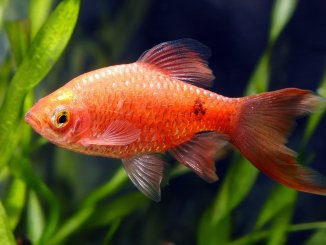
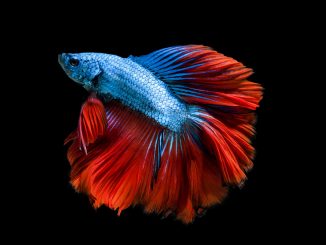
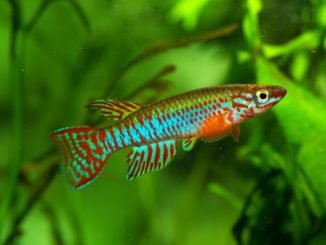
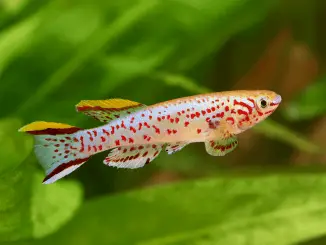
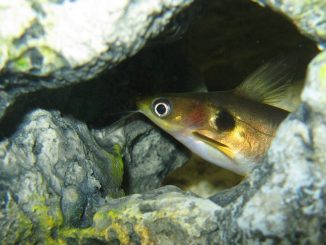
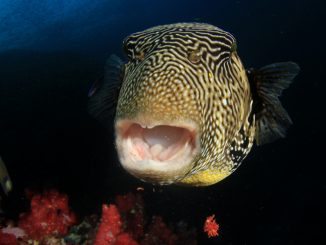
nice this is very helpful, but i wonder if i reqd it right, bettas are also good tank mates for clown killifish?